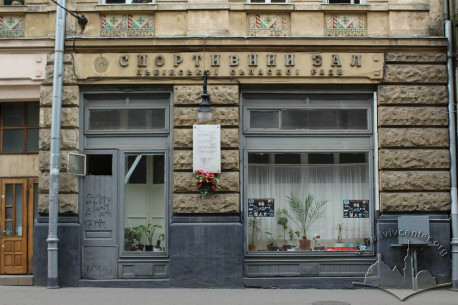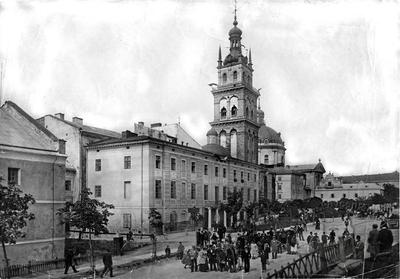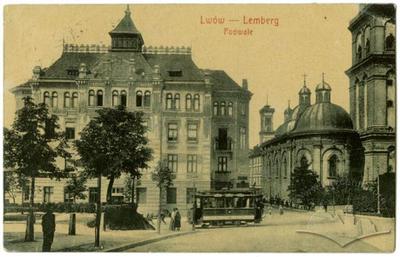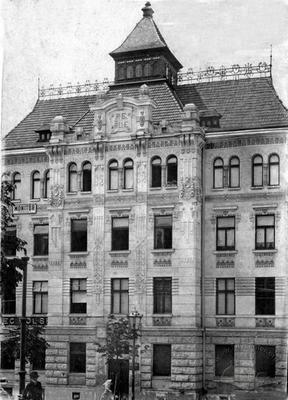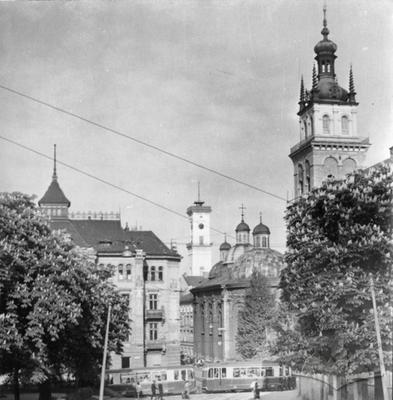Vul. Ruska, 20 – former gyms of "Sokil-Batko" society ID: 2177
The building of the former sports society "Dnister" was built in 1905–1906 by a construction company of Ivan Levynskyi. The architects were Tadeusz Obmiński and Oleksandr Lushpynskyi. It is a monument of architecture and urban planning of local significance: protection number М-250. Presently, it is a communal property (it is owned by a local community of Lviv represented by Lviv City Council). It is used by a medical institution Municipal Polyclinic No 1, and the sports society "Ukrayina."
Story
The design of the building was approved by Lviv magistrate on July, 23, 1905 (DALO 2/2/3806). The design was developed by Tadeusz Obmiński. Oleksandr Lushpynskyi also contributed to the project design. The works were performed by a construction firm of Ivan Levynskyi (construction site supervisor — Filemon Levytskyi). The construction completed in 1906. In the same time, the right lateral wing of the first floor, on the side of Ruska street, hosted a sports and physical exercise society "Sokil-Batko" that rented 4 premises: 2 gyms, a changing room, and a secretariat. The renting of the premises was initiated by a historian Volodymyr Shukhevych, the then head of the society Alfred Budzynovskyi, and the head of "Dnister" society, a well-known architect Vasyl Nahirnyi. "Sokil-Batko" transferred to the new facility from the building No 7 on ul. Podwale that had been dismantled before the construction of the "Dnister" (Трофим'як, 1997, 29-30, 34). The society focused mostly on physical exercises, a combination of gymnastics and acrobatics. At different times, the coaches were Josyf Kotsylovskyi (future bishop of Przemysl), Petro and Taras Franko (children of the writer Ivan Franko), Stepan Hayduchok, Petro Zymaka, Mykhaylo Tril, Yaroslav Blahitka. In the late 1920s, Olha Sukhoverska launched classes in rhythmic gymnastics, or rather aerobics, and sports dancing. The society also laid large emphasis on fencing. The fencing classes were launched by T. Dzhulynskyi. The boxing training group was also rather fruitful, as guided by Yu. Romaniv. In addition, the gyms also hosted the competitions in volleyball, basketball, checkers, and chess (Трофим'як, 1997, 33; Вацеба, 1997, 14-50).
Gyms were duly equipped with different appliances, such as poles, railings, vaulting horses, bounces, bars, wall bars, Swiss chairs, steel and wooden poles, ropes, lifting platforms, etc. The traces of their use stayed on the ceilings in the form of fitted strong anchors and hooks. A larger gym hall, rectangular in shape, was fitted with a wooden gallery where viewers would stay and the referees for the competitions were placed, as well as a competition orchestra (still available). The lateral wall had a niche for fencing gear, outfit, gloves, and masks (now covered with planks). The smaller gym was equipped similarly.
In the prewar period, the society received most fame due to the gymnasts Yaroslav Blahitka and Yevhen Oryshchyn (later, a well-known internationally certified judge).
In 1940, the "Dnister" building was nationalized. Immediately after the war, the gyms passed to the control of "Spartak" society who were running them until 1987. The gyms hosted classes in wrestling, boxing, then gymnastics, and most successfully, fencing. The facility saw fencing exercises of the champion of the ХІХ Olympics in Mexico (1968), and in Munich (1972) Viktor Sydiak, the prize winner of the Olympics in 1968, 1972, and 1976 a foil fencer Vasyl Stankovych; as well as foil fencers Yevhen Rumin, and a sabre fencer Serhiy Prykhodko. Yana Shemiakina, a champion of the London Olympics (2012) also started her training here.
The old gym is still used by athletes. Presently, there is a specially fitted fencing gym run by the sports society "Ukrayina."
Architecture
Historically, the building had cultural educational, commercial, sporting and residential functions. It is a corner building with the façades facing Ruska and Pidvalna streets. It has three floors, and an asymmetrical complex planning layout. The system of inside premises is composed around a spacious courtyard.
In the right wing, on the ground floor, there is a gym that used to be run by the "Sokil-Batko" society. The second gym in the same lateral wing is presently used as a center of physical therapy and massage. The former administrative building of the "Sokil-Batko" is used by a pharmacy store today. The main gym and the massage room still have preserved some gymnastics equipment pieces of the early 20th c.
Related buildings and spaces
People
Yaroslav Blahitka — a leading gymnast of the "Sokil-Batko" in the 1930s.
Alfred Budzynovskyi— a head of Ukrainian gymnastics and sports society "Sokil-Batko" (1901–1908 рр.). Due to his efforts, the gyms
in "Dnister" were rented by the sports society.
Josyf (Josafat) Kotsylovskyi— Doctor of Theology, a bishop in Przemysl. Weight-lifter, and
a gymnast. In 1896, in Prague, he passed an exam to qualify as a teacher
of physical exercise. Chief for gymnastics classes in the gyms of "Sokil-Batko" in the "Dnister" building.
Yevhen Oryshchyn — a gymnast, well known in the 1930s. He was training
in the gyms of "Sokil-Batko" in the building of "Dnister." Later, a highest international qualification judge, worked at Olympics in Mexico (1968), in Munich (1972), in Montreal (1976), and in Los Angeles (1984).
Viktor Sydiak — a sabre fencer, Merited Master of Sports, champion of the 19th
Olympics in Mexico (1968). He started his training in the
gym of the "Spartak" society on vul. Ruska, 20.
Vasyl Stankovych— a foil fencer, Merited Master of Sports, silver medal winner at the 19th Olympics in Mexico (1968). He started his training in the gym of the "Spartak" society on vul. Ruska, 20.
Yana Shemiakina — a sabre fencer, champion of the 30th
Olympics in London (2012). She is the only lady among Ukrainian champions at London Olympics coming from Lviv. She started her training in the gym of the "Spartak" society on vul. Ruska, 20.
Sources
- State Archive of Lviv Oblast (DALO) 2/2/3806.
- Діло, 1906, №223, 3, 17.
- Діло, 1906, №227, 3, 21.
- Ілюстрований народний календар товариства "Просвіта" на рік звичайний 1907 (Львів, 1906).
- Б. Є. Трохим'як, Фізичне виховання і спортивний рух у Західній Україні (з початку 30-х років ХІХ ст. до 1939 р.) (Київ: ІЗИН, 1997).
- Ігор Жук, "Будинок товариства "Дністер", Історико-архітектурний атлас Львова, серія ІІ, зошит 1 (Львів: Центр Європи, 1996).
- О. Вацеба, Нариси з історії спортивного руху в Західній Україні (Івано-Франківськ: Лілея-НВ, 1997).
- Ю. Кордіяк, Чемпіони живуть у Львові (Львів: Каменяр, 1980).
